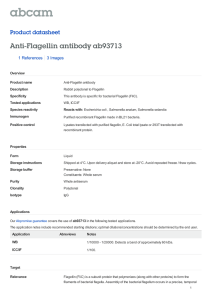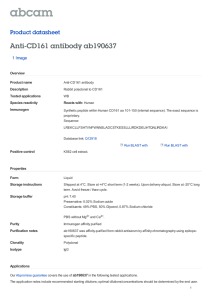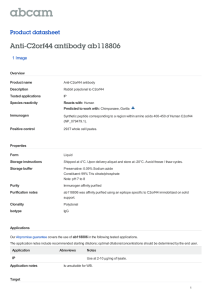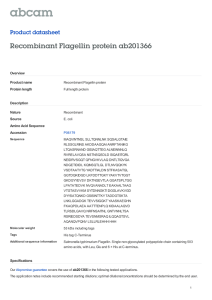Immune Response to Cholera Toxin Epitope Inserted in Salmonella Flagellin
advertisement
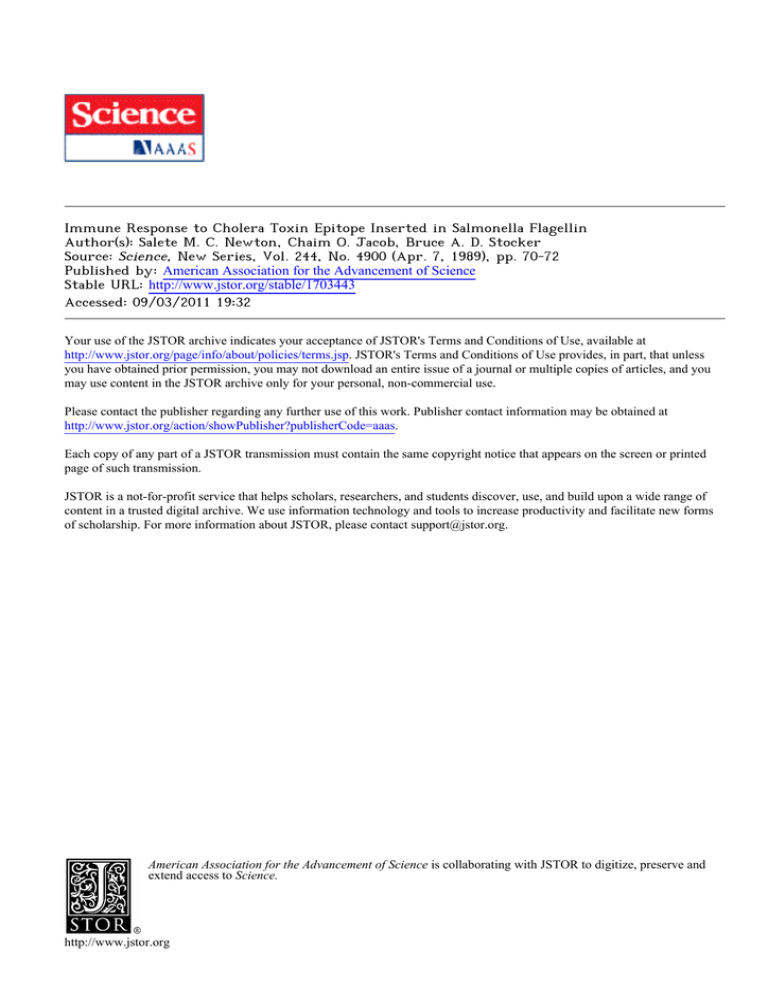
Immune Response to Cholera Toxin Epitope Inserted in Salmonella Flagellin Author(s): Salete M. C. Newton, Chaim O. Jacob, Bruce A. D. Stocker Source: Science, New Series, Vol. 244, No. 4900 (Apr. 7, 1989), pp. 70-72 Published by: American Association for the Advancement of Science Stable URL: http://www.jstor.org/stable/1703443 . Accessed: 09/03/2011 19:32 Your use of the JSTOR archive indicates your acceptance of JSTOR's Terms and Conditions of Use, available at . http://www.jstor.org/page/info/about/policies/terms.jsp. JSTOR's Terms and Conditions of Use provides, in part, that unless you have obtained prior permission, you may not download an entire issue of a journal or multiple copies of articles, and you may use content in the JSTOR archive only for your personal, non-commercial use. Please contact the publisher regarding any further use of this work. Publisher contact information may be obtained at . http://www.jstor.org/action/showPublisher?publisherCode=aaas. . Each copy of any part of a JSTOR transmission must contain the same copyright notice that appears on the screen or printed page of such transmission. JSTOR is a not-for-profit service that helps scholars, researchers, and students discover, use, and build upon a wide range of content in a trusted digital archive. We use information technology and tools to increase productivity and facilitate new forms of scholarship. For more information about JSTOR, please contact support@jstor.org. American Association for the Advancement of Science is collaborating with JSTOR to digitize, preserve and extend access to Science. http://www.jstor.org 36. V. N. Rao and E. S. P. Reddy, unpublished results. 45. J. Crouse and D. Amorese, Focus 8 (no. 3), 8 tic chromosomal translocation, t(18;X) (1986). (qI 1: qi 1), the breakpointon chromosome X 37. N. K. Bhat et al., Proc. Natl. Acad. Sci. U.S.A. 84, 3161 (1987). 46. We thank the Wistar Institute's editorial staff for has been assigned clearlyat Xpl 1.2 (39). The 38. V. N. Rao and E. S. P. Reddy, unpublished results. preparing the manuscript; J. Averback for assistance with computer analysis; K. Nishikura for critical elk-1 gene may be a candidatefor involvement 39. C. C. Turc et al., Proc. Nat!. Acad. Sci. U.S.A. 84, (1987). comments on the manuscript; Y. Fujihara, E. Anin this translocation. elk-2 also maps to a 40. 9981 C. M. Croce et al., Science227, 1044 (1985). gent, and L. Leonard for technical assistance. Supchromosome region, 14q32, which may be 41. L. Mengle-Graw et al., EMBO J. 6, 2273 (1987). ported by NIH grants CA-25875, CA-21124, and CA-39860. near characteristictranslocation breakpoints. 42. S. P. Staal et al., Genomics2, 96 (1988). 43. F. Sanger, S. Nicklen, A. R. Coulson, Proc. Nat!. Chromosome band 14q32, the site of the IgH Acad. Sci. U.S.A. 74, 5463 (1977). and the putative oncogene TCI-1 (31, 40) is 44. U. K. Laemmli, Nature227, 680 (1970). 29 September 1988; accepted 12 January 1989 frequentlyrearrangedin B and T cell tumors. B cell neoplasias exhibit chromosomal rearrangementswithin the IgH locus at 14q32.3, whereasin T cell neoplasiaswith translocation in 14q32, the 14q32 breakpoint usually occurs centromeric to the IgH locus (31, 41). The human proto-oncogene AKT- 1, a homolog of the viral oncogene v-akt, has also been SALETE M. C. NEWTON,* CHAIM 0. JACOB, BRUCE A. D. STOCKER assigned to chromosome band 14q32 centro meric to the IgH locus (42). It remainsto be Bacterial flagella are potent immunogens and aromatic-dependent (aro) Salmonella as seen whether elk or related sequences play a live vaccines evoke humoral and cellular immune responses. Such strains expressing role in the pathogenesisof these malignancies. epitopes of protective antigens as inserts in flagellin would provide a novel way to vaccinate against diseases caused by unrelated pathogens. A synthetic oligonucleotide specifying an epitope of cholera toxin subunit B was inserted in a Salmonella flagellin AND NOTES REFERENCES gene. The chimeric flagellin functioned normally and the epitope was expressed at the 1. D. Leprince et al,, Nature306, 395 (1983). flagellar surface. Parenteral administration to mice of an aroA flagellin-negative strain 2. M. F. Nunn, P. M. Seeburg, C. Moscovici, P. H. of S., dublin expressing the chimeric flagellin gene evoked antibody to cholera toxin. Duesberg, ibid. 306, 391 (1983). Immune Response to Cholera Toxin Epitope Inserted in SalmonellaFlagellin 3. 4. 5. 6. 7. 8. 9. 10. 11. 12. 13. 14. 15. 16. 17. 18. 19. 20. 21. 22. 23. 24. 25. 26. 27. 28. 29. 30. 31. 32. 33. 34. 35. 70 T. Graf et al., Virology99, 431 (1979). M. G. Moscovici et al., ibid. 129, 65 (1983). K. Radke et al., Cell 31, 643 (1982). H. Beug et al., ibid. 39, 579 (1984). H. Beug et al., EMBO J. 1, 1069 (1982). K. Bister et al., Proc. Natl. Acad. Sci. U.S.A. 79, 3677 (1982). K. Klempnauer et al., Cell 37, 537 (1984). K. Moelling et al., ibid.40, 983 (1985). M. Coquillaud et al., OncogeneRes. 2, 335 (1988). J. H. Chen, ibid., p. 371. K. E. Boulukos et al., EMBO J. 7, 697 (1988). D. K. Watson et al., Proc.Natl. Acad. Sci. U.S.A. 85, 7862 (1988). E. S. P. Reddy and V. N. Rao, OncogeneRes. 3, 239 (1988). D. K. Watson et al., Proc.Natl. Acad. Sci. U.S.A. 82, 7294 (1985). E. S. P. Reddy et al., ibid. 84, 6131 (1987). V. N. Rao et al., Science237, 635 (1987). Z. Chen et al., Dev. Biol. 125, 432 (1988). L. J. Pribyl et al., ibid. 127, 45 (1988). D. K. Watson et al., Proc.Natl. Acad. Sci. U.S.A. 83, 1792 (1986). M. 0. Diaz et al., Science231, 265 (1986). N. Sacchi et al., ibid., p. 379. U. Rovigatt et al., ibid. 232, 398 (1986). V. N. Rao et al., Oncogene3, 497 (1988). E. S. P. Reddy and V. N. Rao, in preparation. M. Kozak, NucleicAcids Res. 12, 857 (1984). J. Kyte and R. F. Doolittle, J. Mol. Biol. 157, 105 (1982). Y. Tsujimoto and C. M. Croce, Proc.Nat!. Acad. Sci. U.S.A. 83, 5314 (1988); R. Weiss, N. Teich, H. Varmus, J. Coffin, RNA TumorViruses(Cold Spring Harbor Laboratory, Cold Spring Harbor, NY, 1985). M. Durst et al., Proc. Natl. Acad. Sci. U.S.A. 84, 1070 (1987); K. Huebner et al., ibid. 83, 3934 (1986); K. Huebner et al., Am. J. Hum. Genet. 38, 28, 329 819 (1986); S. Bauer et al., Immunogenetics (1988). G. Russo et al., Cell 53, 137 (1988). P. N. Goodfellow et al., Proc.Natl. Acad. Sci. U.S.A. 79, 1190 (1982). M. E. Harper and G. F. Saunders, Chromosoma83, 431 (1981); L. Cannizzaro and B. S. Emanuel, Cytogenet.Cell Genet. 38, 308 (1984); M. Isobe et al., Proc.Natl. Acad. Sci. U.S.A. 83, 4399 (1986). V. N. Rao et al., unpublished results. M. Isobe, K. Huebner, C. M. Croce, V. N. Rao, E. S. P. Reddy, unpublished results. R ECENT DEVELOPMENTS IN VAC- cine construction include the use of synthetic peptides of relevant antigens from various pathogenic microorganisms (1); the construction of Salmonella strains made nonvirulent by irreversiblemutations and therefore safe for use as live vaccines (2); and the use of these avirulent strains as carriersof cloned genes that specify foreign proteins to obtain an immune response to heterologous protective antigens (3), in much the same way as vaccinia virus carryingforeign genes has been used to confer protection against, for instance, rabies (4). We have combined these approaches by inserting a synthetic oligonucleotide into a cloned Salmonellaflagellin gene; mice given a Salmonellalive vaccine expressing the recombinant flagellin gene showed an immune response to the inserted epitope. The flagellin gene used, HI-d, determines the phase-I flagellarantigen, d, of Salmonella muenchen,a protein of 509 amino acids; its sequence includes a "hypervariablesegment" of about 350 bp with no more than 30% amino acid identity to the corresponding sequences in Salmonellaflagellarantigens i, c, and a (5, 6). Epitopes of flagellar antigens i (7) and d (8) have been identified in the hypervariable regions of genes H1-i of S. typhimuriumand Hl-d of S. muenchen.A chromosomal Eco RI fragment containing Department of Microbiology and Immunology, Stanford University School of Medicine, Stanford, CA 94305. *To whom correspondence should be addressed. HI-d, originally cloned in plasmid pBR322 (5), was transferred to pUC19, a plasmid lacking Eco RV sites, to produce plasmid pLS405; the in vitro deletion of an Eco RV fragment gave plasmid pLS408, with a 48bp deletion in the hypervariableregion (Fig. 1). This deletion reduces but does not abolish flagellar function (as inferred from the motility of a flagellin-negative strain carrying pLS408) and removes one or more epitopes of antigen d (8). The remaining Eco RV site of pLS408 allows the blunt-end insertion of oligonucleotides. The epitope chosen for expression in flagellin, peptide CTP3, consists of residues 50 to 64 of the B subunit of cholera toxin (9); it elicits both polyclonal (10) and monoclonal (11) antibodies that bind to the peptide and bind and neutralize cholera toxin. A synthetic 45-bp, double-stranded oligonucleotide specifying CTP3, with codon usage corresponding to that in sequenced Salmonella flagellin genes (and with a new Cla I site to facilitateanalysis) was inserted at the unique Eco RV site of plasmid pLS408 (Fig. 1). We transformed competent cells of a flagellin-deficient Escherichiacoli strain) CL447 (12), and selected for ampicillin-resistant colonies. The oligonucleotide insert improved flagellar finction, as judged by the rate of spread in semisolid medium of clones with the insert. Recombinant plasmids were sequenced by means of a 15-bp primer located 30 bp downstream from the insertion point. Plasmids found to have a single complete copy of the 45-bp sequence in correct orientation SCIENCE, VOL. 244 (or with 9 bp missing from one or the other end) were transferredto Salmonellahosts, in which the cloned flagellin genes are better expressed than in E. coliCL447. The chosen plasmids were used to obtain ampicillinresistant transformants from S. typhimurium LB5000, a restriction-negative and modification-proficient strain (13) that is nonflagellate because of mutationflaA66, which abrogates expression of the flagellin genes. Phage P22 HT105/1 int was used to transduce the now-modified plasmids to S. typhimuriumSL5676, which has a deletion at H21,2 (the gene specifying the phase-2 flagellar antigen of this species) and a TnlO-generated deletion or deletion-inversion at H1-i that does not affect the function of adjacentfla genes. The ampicillin-resistanttransductants obtained had functional flagella, as shown both by rapid-spreading growth in semisolid medium and by translational motility of nearly all the bacteria of log-phase broth cultures examined by low-power, dark-field microscopy. Protein immunoblots of lysed bacteria or disaggregated flagella showed that a single band bound both rabbit antibody to flagella antigen d (14) and mouse monoclonal antibody to CTP3 (MAb TE33) (Fig. 2). MAb TE33 immediately Ace So pLS408 kb) .1 X(6.4 * - ApR epitopes of surface proteins of hepatitis B virus (18) have also been expressed with this system. In all of these investigations an immune response to the foreign epitope was generated in mice, rabbits, or guinea pigs after administration of either an aroA live vaccine strain carrying the recombinant flagellin gene or killed flagellate bacteria or flagella of such a strain. Thus, the hypervariable region of H1-d is a useful site for the insertion of foreign epitopes into the flagel- A m~~~~4.. .. Fig. 3. Immunogoldlabelingof the CTP3 epitope at the surface of the flagella. Strain SL5676 harboring either plasmid pLS41 1, which has the complete CTP3 insert (A), or plasmid pLS408, with the in vitro deletionbut not the insert(B), were labeledby treatmentwith MAb TE33 and gold-conjugatedgoat antibody to mouse IgG (Janssen) for electron microscope visualization (x 30,000). Hypervariable region Fig. 2. Protein immunoblot COS 0 GTT GAA GTT CCG GGT AGC CAG CAC Ad Va1 Glu Val Pro Gly Ser Gln His Ilo TCT CAG AAA AAA GCT Amp Ser Gln Lys Lys Ala Fig. 1. Structure of plasmid pLS408 and the base sequence of the synthetic oligonucleotide used as the insert. This plasmid was derived from pUCL9 by the insertion, at its Eco RI site, of a fragment that includes gene H1-d from S. muenchen ATCC8388, originally cloned in pBR322 (5) as pLS402, followed by the in vitro deletion of an Eco RV fragment, of 48 bp, in the hypervariable, antigen-determinantsegment of Hl-d. The oligonucleotide used, shown at the bottom, was designed to specify peptide CTP3 with codon usage according with that of sequenced Salmonellaflagellin genes (5, 6) and with a Cla I restriction site; it was made by annealing two 30-base synthetic oligonucleotidesand filling in the single-strand regions by Kienow fragment treatment. The productwas blunt-end ligated to a phosphatasetreated Eco RV digest of pLS4O8. 7 APRIL 1989 immobilized and rapidly agglutinated bacteria of strain SL5676 made motile by pLS41 1, the plasmid with the insert-bearing flagellin gene, but had no effect on the same strain made motile by plasmids with the wild-type gene or on that with the 48-bp deletion. Exposure of the foreign epitope at the surface of the flagella was detected by gold immunolabeling (Fig. 3) of the flagella of Formalin-fixed bacteria, with MAb TE33 as the first antibody. For tests of immunogenicity we replaced the phase-1 flagellin gene, Hl-gp of aromatic-dependent live-vaccine S. dublin strain SL1438 (3) with a flagellin allele inactivated by a transposon, Hl-i::TnlO; as S. dublinis monophasic, the resulting strain, SL5928, was nonmotile but became motile when transformedwith plasmids containing either the wild-type, the deletion, or the chimeric form of HM-d,just as observed for the flagellin-negative S. typhimuriumhost, SL5676. The pUC-derived plasmids are stable in the live vaccine strain used, as shown by the ampicillin resistance of all of more than 100 colonies from a bacterial suspension after two passages in broth without ampicillin and by the ampicillin resistance of all colonies recovered from mouse livers at autopsy. We immunized C57BL/6 mice with three intraperitoneal injections of 5 x 106 bacteria, either Formalin-killed or live, at 7-day intervals. A week after the last injection the mice were bled and their sera were tested by enzyme-linked immunosorbent assay (ELISA) for reactivity with CIP3 peptide or whole cholera toxin (Fig. 4). We detected antibody to the inserted epitope in all the sera; all sera reacted as strongly with cholera toxin as with the CIP3 peptide. Epitopes of gpl20 of human immunodeficiency virus type 1 (HIV-1) (15), of Plasmodium berghei circumsporozoite protein (16), of an epitope of the M protein of Streptococcus pyogenestype 5 (17), and of two 1 2 analysis of Salmonellatyphimurium SL5676 harboring various flagellin plasmids. Bacterial ex- tractswere reactedwith rabbit 3 ; 60 kD- . 4 5 6 7 8 9 10 . .. : antibody to flagellar antigen d (lanes 1 through 5) or with MAb TE33 (anti-CTP3) (lanes 6 through 10). Lanes 1 and 6, pLS402 (parent plasmid); lanes 2 and 7, pLS408 (the in vitro deletion mutant); lanes 3 and 8, pLS411 (complete CTP3 insert); lanes 4 and 9, pLS415 (insert lacks the first 9 bp of the CTP3-specifying oligonucleotide); lanes 5 and 10, pLS416 (insert lacks the last 9 bp of the CTP3-specifying oligonucleotide). TE33 is an immunoglobulin GI (IgGI) mouse MAb to a peptide (residues 50 to 64) of cholera toxin subunit B (11). TE33 antibodies from ascites fluid of BALB/c mice were purified by precipitation with 45% ammonium sulfate (twice) and chromatography on a DEAE-Sephacel column. Bacterial protein extracts were subjected to electrophoresis on a 10% SDS-polyacrylamide gel and blotted onto nitrocellulose sheets, which were probed with the indicated antibodies and then with peroxidase-conjugated goat antibody to rabbit IgG (for antiflagellin) or peroxidase-conjugated goat antibody to mouse IgG (for TE33). The absence of amino acids 50 to 52 of the epitope in pLS415 (lane 9) did not affect the binding of MAb TE33, but the absence of amino acids 62 to 64 (lane 10) reduced binding of this monoclonal antibody. REPORTS 7I 2- E 3. CL 4. 0 5. 01 50 100 200 400 800 1600 3200 6400 Reciprocaldilutions Fig. 4. Antibody response of five mice immunized with SL5929, a Salmonelladublinlive vaccine strain that expresses the chimeric flagellin genes; [1, before immunization, U, after immunization with SL5929. Reactivity of mouse sera with whole native cholera toxin was measured by solidphase ELISA (9), with peroxidase-conjugated goat antibody to mouse IgG (TAGO). Mice were injected intraperitoneally three times, at weekly intervals, with 5 x 106 Formalin-killed bacteria; sera were collected 7 days after the last injection. The bars represent the mean optical density for sera from five mice (SE <15% for all dilutions). lar antigen, and the altered Salmonella strains, when used as vaccines, can cause the production of antibodies specific for the foreign epitope (19, 20). Some inserts three times as long as the 16-amino acid deletion are compatible with flagellar fiuction (18). This flexibility indicates that it may be feasible to insert several epitopes of a protective antigen (at one or more sites), to increase the chance of an immune response, despite the probability that a given epitope will be ineffective in some subjects of an outbred population. Some in-frame inserts did not confer motility on a flagellin-negative host; we are investigating what constraints exist for retention of fimction. In results to be presented elsewhere, we provide evidence that an epitope placed in the flagellar filament protein can elicit a cellular immune response, as shown by proliferative response of cultured spleen lymphocytes to the relevant peptide (21). The ability to (i) synthesize peptides for the identification of antigenic and protective epitopes from pathogens, (ii) insert the corresponding oligonucleotides into flagellin genes, and (iii) use safe and effective live vaccine strains of Salmonellathat induce cellular and humoral immunity makes possible the construction of vaccines for protection against infections for which immune prophylaxis is presently not feasible. REFERENCES AND NOTES 1. R. Arnon, TrendsBiochem.Sci. 11, 521 (1986). 2. S. K. Hoiseth and B. A. D. Stocker, Nature291, 238 (1981); J. A. Robertsson et al., Infect. Imnaun.41, 742 (1983); B. P. Smith et al., Am.J. Vet. Res. 45, 59 (1984); B. P. Smith, M. Reina-Guerra, B. A. D. 72 6. 7. 8. 9. 10. 11. 12. 13. 14. 15. Stocker, S. K. Hoiseth, E. Johnson, ibid., p. 2231; 16. W. R. Majarian, S. J. Kasper, R. N. Brey, in T. K. S. Mukkur, G. H. McDowell, B. A. D. preparation. Stocker, A. K. Lascelles, J. Med. Microbiol.24, 11 17. E. Beachey, S. M. C. Newton, B. A. D. Stocker, (1987). unpublished observations. J. Clements, F. L. Lyon, K. L. Lowe, A. F. Farrand, 18. J. Y. Wu, S. M. C. Newton, B. A. D. Stocker, W. S. Robinson, in preparation. S. E. Morshdy, Infect.Immun.53, 685 (1987); G. Dougan, C. E. Hormaeche, D. J. Maskell, Parasite 19. The advantageof this approach is exemplified by the fact that although in our experiments CTP3 exImmunol.9, 151 (1987); T. P. Poirier, M. A. Kehoe, pressed within the flagellin protein induced antipepE. H. Beachey, J. Exp. Med. 68, 25 (1988). M. Mackett, G. L. Smith, B. Moss, Proc.Nail. Acad. tide response, CTP3-f3-galactosidase hybrid protein Sci. U.S.A. 79, 7415 (1982); T. J. Wiktor et al., in E. coli did not lead to detectable production of antipeptide antibody, although a "priming"immune ibid. 81, 7194 (1984). L. N. Wei and T. M. Joys, J. Mol. Biol. 186, 791 response could be obtained. Even the presence of the OmpF signal peptide at the amino terminus of (1985). T. M. Joys, J. Biol. Chem. 260, 15758 (1985). the hybrid protein (which would have made the __ and J. F. Martin, Microbios7, 71 (1973); T. fusion protein a component of the bacterial outer M. Joys, ibid. 15, 221 (1976). membrane) did not lead to an immune response S. M. C. Newton and B. A. D. Stocker, unpublished against C0P3. C. 0. Jacob, M. Leitner, A. Zamir, D. Salomon, R. Amon, EMBOJ. 4, 3343 (1985). observations. C. 0. Jacob, M. Sela, R. Arnon, Proc.Natl. Acad.Sci. 20. After the completion of our work we saw the report U.S.A. 80, 7611 (1983). by G. Kuwajima et al. [Bio/Technology6 (no. 9), C. 0. Jacob, M. Sela, M. Pines, S. Hurwitz, R. 1080 (1988)] on the insertion of an oligonucleotide Arnon, ibid. 81, 893 (1984). specifying an 11-residue epitope of egg-white lyso27, 717 (1988). J. Anglister et al., Biochemistry zyme at the site of a deletion in the central region of Strain CL447 is a plasmid-free segregant of a strain the flagellin gene, hag, of E. coli; the chimeric (that we named CL402) given to us by T. M. Joys as flagellin filaments bound antibody to a lysozyme E. coliC600 hagharboring plasmid pBR322 with an fragment but their injection into guinea pigs did not Eco RI insert that includes HJ-d of S. muenchen evoke antibody able to bind the lysozyme fragment. 21. S. M. C. Newton, L. Rosenberg, B. A. D. Stocker, ATCC8388 (5); we designate this plasmid pLS402. L. R. Bullas and J.-I. Ryu, J. Bacteriol.136, 471 unpublished observations. 22. Supported by grant 000553 from the American (1983); K. E. Sanderson and B. A. D. Stocker, in coliandSalmonellatyphimurium; Cellularand Foundation for AIDS Research (to B.A.D.S.), a gift Escherichia from Praxis Biologics Inc., and a postdoctoral felMolecularBiology,J. L. Ingraham et al., Eds. (American Society for Microbiology, Washington, DC, lowship from Funacao de Amparo a Pesquisa Estado de Sao Paolo, Brazil (to S.N.). We thank T. M. Joys 1987), pp. 1220-1224. for providing strains and plasmids, P. H. MIkela for The anti-d (SalmonellaH) serum used, from P. H. supplying the anti-d serum, and M. Hovi and L. MIkela, was raised in rabbits by injection of killed whole flagellate bacteria. Rosenberg for assistance and comments. B. A. D. Stocker and S. M. C. Newton, unpublished 29 September 1988; accepted 12 January 1989 observations. Heritable Allele-Specific Differences in Amounts of apoB and Low-Density Lipoproteins in Plasma Dov GAVISH, ELIOT A. BRINTON, JAN L. BRESLOW* Low-density lipoprotein (LDL) concentrations correlate with risk of coronary heart disease, and genetic variation affecting LDL levels influences atherosclerosis susceptibility. The principal LDL protein is apolipoprotein B (apoB); apoB is not exchangeable between lipoprotein particles and there is only one apoB per LDL particle. Plasma LDL therefore consists of two populations, one containing apoB derived from the maternal and one from the paternal apoB alleles. Products of the apob gene with high or low affinity for the MB-19 monoclonal antibody can be distinguished, and this antibody was used to identify heterozygotes with allele-specific differences in the amount of apoB in their plasma. A family study confirmed that the unequal expression phenotype was inherited in an autosomal dominant manner and was linked to the apob gene locus. Significant apoB genetic variation affecting plasma LDL levels may be more common than previously appreciated. A B (APoB) IS A POLIPOPROTEIN constituent of several types of lipoprotein particles and exists in two forms, B-100 and B-48. The B-100 protein, which is made primarily in the liver, is virtually the only protein in low-density lipoprotein (LDL) and mediates the interaction of LDL with its receptor (1-4). Defects in the apob gene have been described that result in diminished plasma apoB in the disorder hypobetalipoproteinemia (5-8). As a consequence, homozygotes have little or no plasma LDL cholesterol, whereas heterozygotes have approximately 30% of normal levels (5). These observations suggest that other defects in the apob gene might also influence LDL cholesterol levels. We now report that there are heritable differences in the contribution of specific apob alleles to plasma apoB concentrations. The Rockefeller University, 1230 York Avenue, New York, NY 10021. *To whom correspondence should be addressed. SCIENCE, VOL. 244
